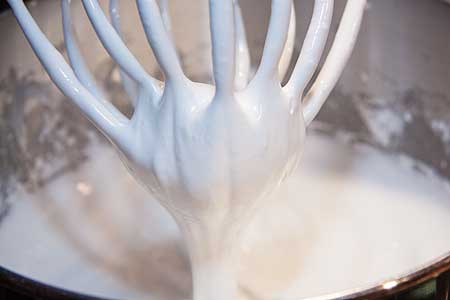
Egg whites may be whipped to as much as eight times their original volume. Whipping not only adds air to the whites but causes the proteins to bond, giving strength to the foam. These few tips on how to whip egg whites will help you get the best results.
Fresh Eggs
A fresh egg has a thick white that takes longer to whip than an older egg. A fresh egg also makes less volume. But the foam is more stable and less apt to collapse when combined with other ingredients.
An older egg has a thinner white that whips faster. It makes more volume, but is less stable and therefore tends to somewhat collapse when folded with other ingredients.
The end volume is exactly the same. So you needn’t rush eggs from the coop to the kitchen before making a recipe calling for whipped whites.
Separating Yolk from White
Any bit of yolk in the whites introduces fat and inhibits whipping. To avoid getting a bit of errant yolk from one egg into all the whites, separate each white into a smaller bowl before adding it to the beating bowl. That way if a yolk happens to slip in, you can discard that egg or save it for some other purpose without ruining the whole batch.
Eggs are easiest to separate when they are cold. But cold proteins don’t expand as well as warm proteins. Your whites will therefore beat to their greatest volume if you first separate them and then warm them to room temperature for about 30 minutes.
Adding a pinch of salt to the separated whites helps firm up their proteins. The result will be greater loft.
Choose Your Bowl
Since the smallest amount of fat interferes with the bonding process, take care to avoid using a bowl with the slightest bit of oil residue. A plastic bowl is unsuitable for beating egg whites, because plastic tends to absorb fat. Using the same plastic bowl that you used to make potato salad or corn muffins with plenty of tasty, if fatty, ingredients therefore won’t yield good results.
Most chefs who know all about how to whip egg whites use a copper bowl, which improves the whites’ ability to expand. A minute amount of copper from the bowl reacts with conalbumin in the egg white to stabilize the foam so the beaten-in air won’t leak right back out.
Before each use, clean the copper bowl with a mixture of one tablespoon salt and ¼ cup lemon juice or vinegar. Then wipe it dry with paper towels.
If you don’t have a copper bowl, you can get similar results in a glass or stainless steel bowl. Just add an acid ingredient such as cream of tartar, lemon juice, or vinegar to stabilize the foam and keep the bubbles from bursting when you stop beating.
As the whites are just beginning to froth, add 1/8 teaspoon of an acidic ingredient per egg white. If you’re making a meringue, add 1/8 teaspoon per two whites.
Choose Your Beater
As with your bowl, avoid using a beater with the slightest bit of oil residue. Similar to fat, water also inhibits foam formation, so be sure both your bowl and beaters are dry before you start.
Unless you’re using a copper bowl — in which case whites may be beaten with a whisk or hand mixer — you’ll get best results with an electric mixer. Start beating at slow speed for 1 to 2 minutes. The more whites you beat, the longer it will take.
As foam develops, increase the speed and beat for another 2 to 3 minutes. Stop beating when the foam is firm and glossy and at its sturdiest.
A Peek at Peaks
Some recipes using whipped egg whites call for soft peaks. Others call for stiff peaks. What’s the difference?
Soft peaks are glossy and curl over slightly when the beater is lifted out of the bowl. When the bowl is tilted, the foam slips against the side.
Stiff peaks are firm and glossy and do not slump when the beater is lifted. When the bowl is tilted, the foam will not slip.
Overbeating
Overbeaten whites are stiff and dry. They separate into cloudlike clumps that lack elasticity to form peaks and won’t readily blend with other ingredients. In overbeaten whites, the liquid will separate out and the foam will deflate.
In that case the whites will be stiff and dry and will collapse when you add other ingredients. The same thing happens if you leave the foam too long before proceeding with your recipe.
Not to worry! You can restore overbeaten whites by carefully beating in an additional room-temperature white.
Adding Ingredients
Adding sugar to the beaten whites lets the foam keep longer before separating, but won’t let it peak as firmly. When making a recipe calling for sugar, beat the whites almost until they reach full volume, then gradually add one or two tablespoons of sugar at a time. Adding the sugar before beating dilutes the protein so the whites won’t beat to full volume.
Immediately and gently fold in any other ingredients called for in the recipe you are making. Don’t stir them in, but fold, gently, to avoid collapsing the foam.
While your recipe is cooking, heat will expand the beaten-in air cells and the egg proteins surrounding them will firm up, giving your foam a permanent structure. You should have great results with all your recipes, now that you know how to whip egg whites.
And that’s today’s news from the Cackle Coop.
Gail Damerow is the author of Storey’s Guide to Raising Chickens. The image is by Stefan Schweihofer from Pixabay.

